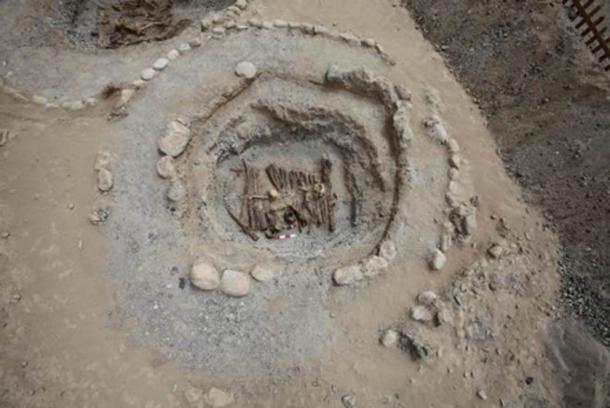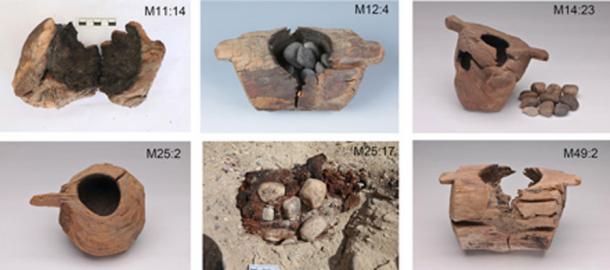Ancient Chinese Death Rituals Involved Smoking Cannabis Specifically “To Get High”
Archaeological evidence gathered at the excavation of ‘eight ancient Chinese tombs’ has finally determined that people were indeed smoking cannabis 2,500 years ago, just to “get high”.
The eight tombs explored are situated in the Jirzankal cemetery in the Pamir mountain range near the Himalayas and were discovered inside “circular mounds with stone rings” with black and white striped patterned stones arranged on top. According to the paper published in Science Advances journal, by a team of scientists from the Chinese Academy of Sciences and the Max Planck Institute, “the vessels are the first evidence of people using marijuana recreationally.”

A - Plan view of the Jirzankal Cemetery where the evidence of cannabis use was found; B - black and white stone strips on the cemetery surface; C - circular burial mounds with stone rings. (Xinhua Wu / Science Advances)
The smoking gun in the scientists’ investigation was their discovery of the psychoactive chemical in marijuana, tetrahydrocannabinol (THC), which was found in pollen samples extracted from wooden fragments taken from “10 wooden incense burners”. These samples were analyzed using ‘gas chromatography-mass spectrometry’ and the traces of THC measured “at higher levels than found in wild cannabis plants” suggesting selected varieties of cannabis, that had higher levels of THC, were grown “specifically” for getting folk out of their proverbial boxes, or tombs, as the case may have been.
Mourners Getting High, As Souls Get Low
The scientists think that during funerary rituals, to enhance the perceived sacrality of the event, cannabis smoke from the burners would have stimulated the mourners senses - effectively getting them high. Experienced users might have used the experience to enhance ritual communications with divine realms during the passing of the dead person’s soul to the Other world.
- Norwegian Vikings Cultivated Cannabis
- Magu: The Hemp Goddess Who Healed Ancient Asia
- New Research Provides First Peek at Ancient Mesopotamian Drug Use

The incense burner in one of the tombs can be seen at the middle bottom edge of the central circle of this fire pit. (Xinhua Wu / Fair Use)
And while these applications of the THC smoke are quite predictable, what wasn’t expected, according to a report in The Independent , was the new data pertaining to “how people started cultivating the plant for its psychoactive properties.”
While it is known cannabis plant fiber was used for making sails and clothing, and that cannabis seed oil was used in east Asia from at least 4000 BC, scientists had little understanding of the early use of cannabis for getting high. These new findings corroborate previously ascertained evidence of cannabis use further north “in the Xinjiang region of China and in the Altai mountains of Russia”, according to the paper.
Ancient Chinese Cannabis Connoisseurs
The team of scientists were able to trace the genetic heritage of the THC and evidence suggested that cannabis “probably spread across trade routes along the early Silk Road” before evolving into what The Independent described as “the most widely used psychoactive drug in the world.” The lead archaeologist, Robert Spengler, said the early Silk Road “functioned more like the spokes of a wagon wheel than a long-distance road, placing central Asia at the heart of the ancient world.”
Professor Yang Yimin, the lead analyst for the study, said the study “helps us understand early human cultural practices, and speaks to the intuitive human awareness of natural phytochemicals in plants.” The study implies cannabis smoking of “high chemical-producing varieties” were among “the cultural traditions that spread along these exchange routes.”

Wooden braziers showing cannabis use were excavated from the cemetery. (Xinhua Wu / Science Advances)
Several of the skeletons recovered from the tombs resemble “those of contemporaneous peoples further west in central Asia” and they have proven that “not all of the people buried there grew up locally.” The scientists concluded that “modern perspectives on cannabis vary tremendously cross-culturally, but it is clear that the plant has a long history of human use, medicinally, ritually, and recreationally, over countless millennia.”
High Or Pain-Free?
Only 3 weeks ago I wrote a news piece on Ancient Origins about another paper published in the journal Vegetation History and Archaeobotany detailing the work of a team of researchers from the University of Vermont who proved the cannabis plant “evolved 28 million years ago at a specific area on the Tibetan plateau.” Based on a “synthesis of subfossil pollen and archaeobotanical studies”, from data including “155 fossil pollen studies” the study established the oldest common ancestors of the cannabis plant. These scientists also speculated about the “recreational” usage of the drug.
Is it just me, or has the entirety of North America not just legalized “Medical” weed, not “getting stoned” weed? Would it not make equal sense that ancient Chinese people smoked THC to ease arthritic pain, inflamed nerves and to exterminate anxiety and sleeping disorders? Surely they too knew about the “Entourage effect”?
The “Entourage effect” is a medical term which has arisen from modern studies describing the powerfully beneficial healing effects of combining tetrahydrocannabinol (THC) (the psychoactive component of the cannabis plant), with Cannabidiol (CBD) from the ‘whole plant’, A Wired article explains how “Researchers only discovered the endocannabinoid system in the early 1990s” but it is known that CBT and THC bind to receptors in the human body’s endocannabinoid system, specifically the CB1 and CB2 receptors; regulating mood and immune system functions.

Cannabidiol, CBD, is from the entire cannabis plant. (cendeced / Adobe Stock)
This is my departing argument for the ancient use of “Medical” cannabis: in a culture that used: "black henbane”, “cat’s claw flowers" and “laughing mushrooms” at funerary rituals, there is no cannabis plant on this planet that would have ‘cut through’ the intense psychedelic effects of these substances; if anything, they smoked weed to calm them down and to haul them back to this world.
Top image: Wooden brazier used for recreational cannabis use. Source: Xinhua Wu / Science Advances
By Ashley Cowie

















